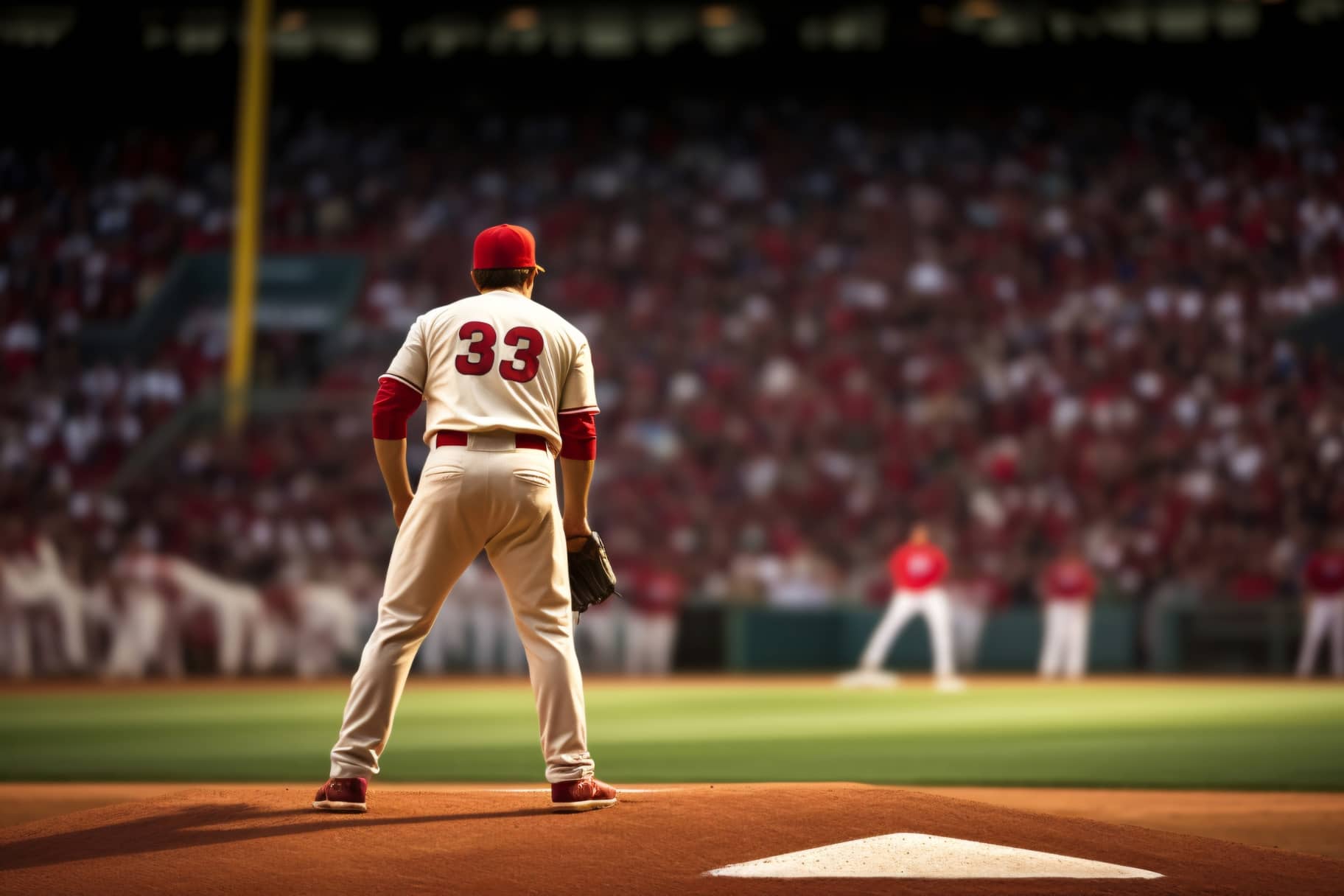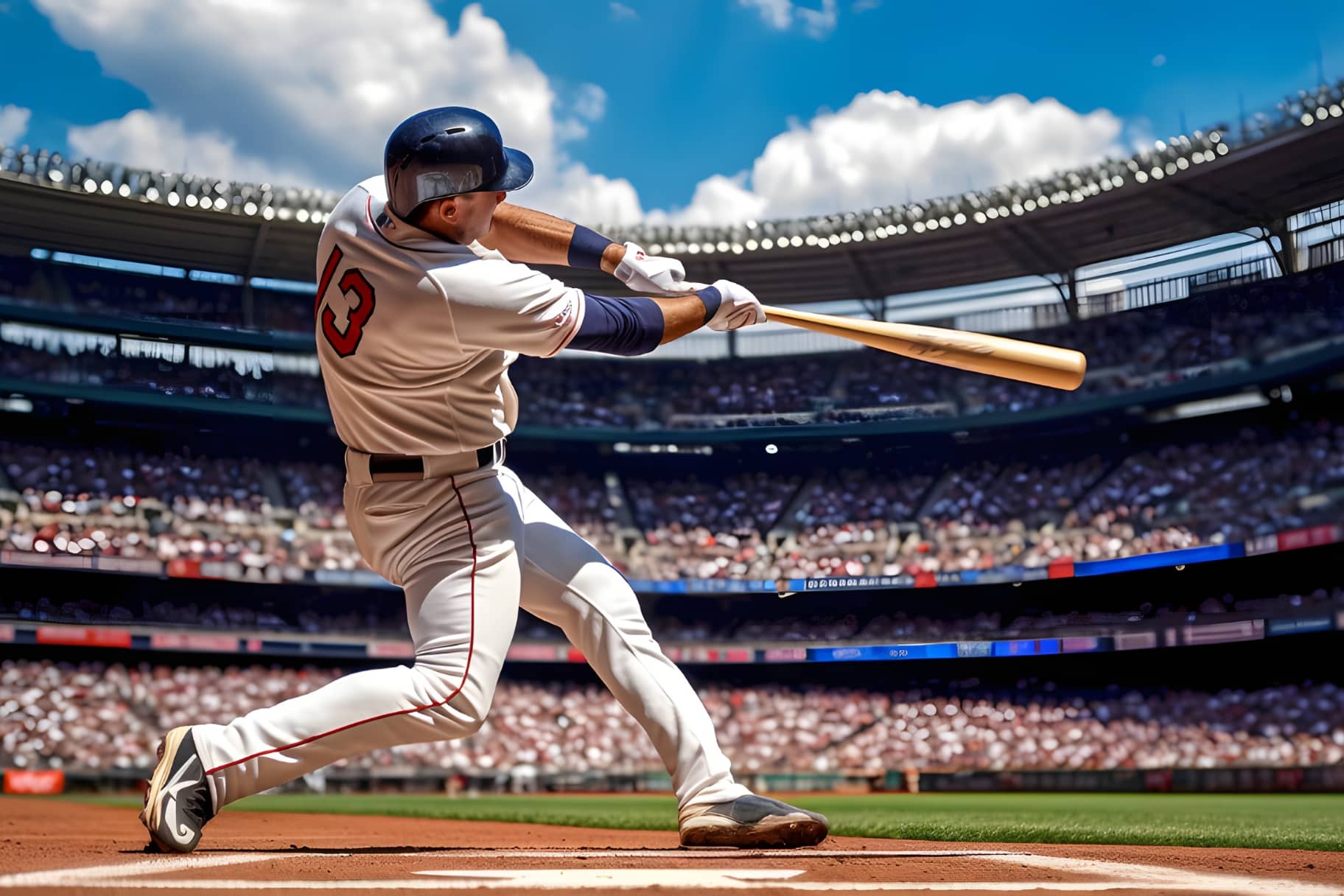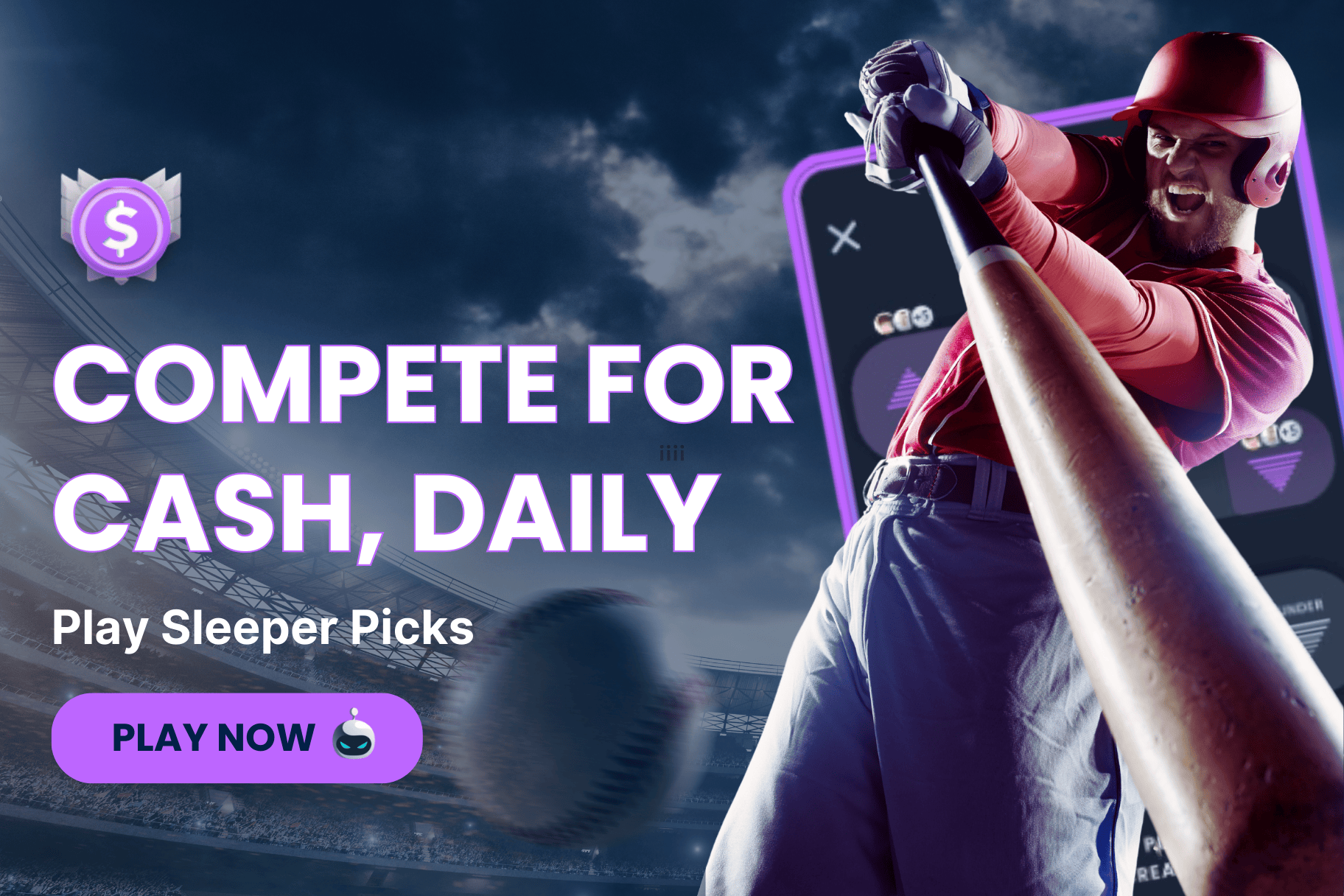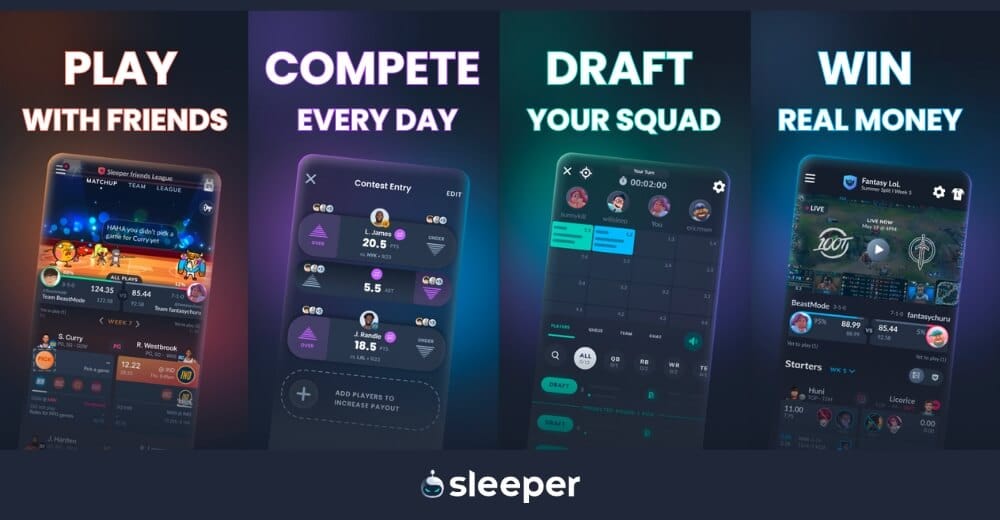Diving into fantasy baseball for the first time can be intimidating, but we’ll help you clear that initial hurdle and find a new life-long obsession.

Baseball has long been dubbed America’s Favorite Pastime, but Fantasy Baseball has also become one of America’s favorite ways to pass the time.
With roots that pre-date the public availability of the internet, fantasy baseball’s creators used ancient artifacts called newspapers to score their league and determine a champion.
Nowadays, it’s all at our fingertips, with apps like Sleeper that allow you to secure bragging rights with your friends while spending your summers watching baseball.
If you’re new to the concept of fantasy baseball and want to see what all the fuss is about, but aren’t quite sure where to start, you’ve come to the right place.
What Is Fantasy Baseball & How Does It Work?

Calling it Fantasy Baseball makes it sound like you’re living out some dream of playing Major League Baseball, when it’s much more like playing dress-up as a big league manager. In fact, fantasy players often refer to each other as managers (or owners), while the person in charge of running the league and finding a draft date/time that works for everyone’s schedule—Spoiler alert: That window on the calendar never exists—is given the title of league commissioner, or “commish.”
Now, as a fantasy manager, you get to skip a lot of the real-life managerial duties. You don’t have to worry about clubhouse morale. And unless you’re in the most diabolical league ever created, you won’t be placed in front of a microphone and asked to publicly explain a decision that backfired.
As a (fantasy) baseball manager, your No. 1 goal is putting together the lineup and rotation that gives your team the best possible chance of winning it all.
Whether you win or lose in fantasy baseball is all based on what actually happens on the MLB diamond.
We’ll get into the various league and scoring types shortly, but the common factor across all options is when a player on your team records a real-life statistic, your fantasy team scores accordingly.
If your shortstop hits a home run, boom, your fantasy team gets credited a home run.
If your pitcher gives up a grand slam, though, ouch, your fantasy team’s ERA is probably going to spike.
On and on it goes on a nightly basis for six months until a champion is crowned. Perhaps that champ wins some sort of prize, but they definitely get an offseason full of bragging rights — which might be the main reason we play this silly, aggravating, euphoric game year after year.
Ready to get started playing fantasy baseball?
Awesome!
Now you just have to choose from the plethora of formats available.
Are There Different Types of Fantasy Baseball Leagues?
There are two primary forms of fantasy baseball: DFS (daily fantasy sports) and season-long.
DFS
In DFS, players are assigned a ‘monetary’ value each day and you have a salary cap to construct a roster. You might have a completely different roster from one day to the next, or do a bunch of different rosters on the same day. Some people use forecasting models and lineup optimizers to enter literally hundreds of pools per day and might go through the entire summer without once seeing the sun.
There are a number of other types of daily fantasy formats that fall under the umbrella of DFS, including Sleeper Picks, where you select two or more players and pick whether they will gain more or less than their daily projected performance metrics (runs, hits, etc.) Suffice to say, DFS is the fantasy baseball equivalent of day-trading stocks.

We’re going to primarily focus on season-long leagues from this point forward, though. That is typically what people play when first getting into fantasy sports and by far the more common method for competing with a group of friends. However, if you prefer a format where your season isn’t liable to be completely derailed by a rash of April injuries, DFS might be for you.
Season-Long Leagues
Season-long leagues are, well, exactly that. You draft your team — more on drafting in a bit — and then you tinker with that roster throughout the season until you drive yourself to the brink of insanity.
But don’t worry. It’s a fun journey.
Scout’s honor.
Whereas in DFS it’s possible that one player could be selected by everyone in the pool, in season-long leagues a player can only be owned by one manager at a time. That manager has to choose whether to start or bench that player on any given day, can trade that player to another manager or might choose to drop that player to the waiver wire to pick up someone else. But once you acquire a player, he is yours and only yours, until you decide he’s not yours anymore.
If you want to really make a player yours, though, why stop at a season-long league when you could have a seasons-long league?
Redraft League
The standard, one-year league is known as a Redraft League. You start over from scratch every spring.
Keeper League
For more commitment, you can do a Keeper League, in which you have the option of retaining a few (usually three or four) of your best players from one season to the next.
Dynasty League
If you really fancy yourself a die-hard, there’s a Dynasty League format, where you might keep your entire roster and spend multiple years trying to cobble together a contender, just like a real franchise.
For more on the differences between keeper leagues and dynasty leagues, click here. (Link once published.)
How Do You Build a Roster?

At this point, you’re surely wondering how you acquire the players that make up your roster.
It starts where your season does: The draft.
As with the league type itself, there are two primary options here.
Snake / Standard Draft
The tried-and-true, gateway drug of drafting a fantasy team, a snake draft involves managers picking players one-by-one in a preassigned order. The order is often randomized one hour prior to the draft, but a next-level commish might get creative and let a round of golf determine draft order.
Where the “snake” part comes in is that the queue flips with each round. If you have the first pick in a 10-team league, better make it a good one, because you’re not drafting again until the last pick of the second round (20th overall). At least you’ll have the first pick in the third round, though, as you serpentine your way through the draft order until rosters are complete.
Auction / Salary Cap Draft
An auction draft gives every manager a set amount of fictional money they can use to bid on players. Players go to the highest bidder until everyone’s roster is full.
In a snake draft, if you get stuck with the last pick of the first round, there are a bunch of elite players you’ll never even have the option of selecting. But in an auction draft, you can bid on whomever you want, whenever you want.
The budget for an auction draft is typically 260 pretend dollars. You don’t have to spend your entire budget, but you will need to spend at least one dollar on each player and must fill your entire roster (usually 23 players).
If you want to blow 90 percent of your wad on five of the best players and round out the rest of your roster with players who can be purchased for a dollar or two, that’s called the “stars and scrubs” strategy, and you are well within your rights to use it. It’s one of a myriad of approaches that can be taken with an auction draft, making this the format that requires more pre-draft research and planning.
Read more: Fantasy Baseball Drafting Strategy
Fantasy Baseball Lineups and Roster Management
The draft is just the beginning, though.
Even if you completely botch your draft — or forget about it and get auto-drafted a whole bunch of injured players, which happens to the best of us — you might be able to salvage your season. Because right here is the crux of season-long fantasy baseball: Setting your lineup and making add/drops.
Your lineup will more or less mirror that of an actual baseball team:
- Catcher
- First baseman
- Second baseman
- Third baseman
- Shortstop
- Three outfielders
- Designated hitter / utilityman
- Pitchers (both of the starting and relief variety)
- Bench spots
- “Bonus” slots for players on the Injured List (IL)
Ultimately, positions may vary from league to league. Some leagues might have a second utility spot, or will use corner infielders and middle infielders instead of mandating one from each infield position. But let’s just say you’re probably not going to have a roster with 23 outfielders.
Notably, statistics accrued by the players on your bench do not count, so make sure you’re updating your lineup regularly, so as to not leave too many home runs and stolen bases on your bench.
Managing Free Agent Pickups
In addition to your team’s roster is your potential roster, AKA the pool of free agents. Any player who isn’t presently on a team is available to be picked up. However, you are never allowed to exceed your league’s roster limit, so you’ll either need to drop one player to pick up another or place an injured player (whom you already own) on your IL — which doesn’t count against your roster limit, but typically has a finite space of its own.
In most leagues, free agents are simply first come, first serve. You see a guy you want and you can immediately make him part of your roster. Unless the player was recently dropped by another manager, in which case he needs to clear waivers before reaching free agency, as is the case when a player gets cut in real life. It typically takes a day or two for players to come off the waiver wire.
Some leagues will use a free-agent acquisition budget (FAAB), which is a daily silent auction where each manager has a FAAB that they need to make last for the entire season.
Beware there might/should be limits on how many pickups you can make per week and/or a limit on how many starting pitchers you are allowed to use in a week/season. This is to prevent “streaming,” which is the practice of incessantly picking up pitchers who are starting that day, all but guaranteeing you will win the wins and strikeouts category. Don’t be a streamer. No one likes a streamer.
The final (and easily most entertaining) method of roster-building is trading with other managers. When that “A Trade Offer from Someone in Your League” email hits your inbox out of nowhere, might as well just clear your calendar for the next 90 minutes, because things are about to get wild.
So…How Do I Score Fantasy Points?

Now that you’ve got your roster, how does the scoring work?
You guessed it: There are several options.
In fact, there are options within the options as far as which statistics your league will use. The basics, though, are runs, home runs, RBI, stolen bases and batting average for hitters; wins, saves, strikeouts, ERA (earned runs allowed per nine innings pitched) and WHIP (walks + hits / innings pitched) for pitchers.
Regardless of which of these four scoring systems your league uses, sluggers who also steal bases and starting pitchers who rack up strikeouts are always a crowd-pleaser.
Rotisserie (Roto)
No, there’s no chicken involved here. This O.G. scoring format was named after NYC restaurant La Rotisserie Française, where fantasy baseball was “founded” in 1980 by Dan Okrent and friends. In “Roto” leagues, standings are based on where your team ranks in each of the league’s stat categories. If it’s a 10-team league and your players hit the most home runs but steal the fewest bases, you’ll get 10 points for the former and just one point for the latter. Highest overall score at the conclusion of the final day of the regular season wins the league.
Head-to-Head Categories (H2H)
Instead of trying to outperform the entire league throughout the season with Roto, in H2H you’ll be matched up each week with an opposing manager for a one-on-one battle. In some leagues, it doesn’t matter how many categories you win by — you either win the week or lose it. In others, though, each category counts toward your record in the standings. In those leagues, winning every category in a week can be a colossal game-changer, as opposed to eking out a 6-4 type of victory.
Head-to-Head Points (H2H)
Same general concept as H2H Categories, except instead of trying to make sure you win enough categories to win the week, each stat is assigned a point value — and you can win a week while only winning one or two categories if you absolutely dominate in those stats. For H2H Points, you’ll often see total bases used instead of home runs, and there are more categories for pitchers, who get negative points for allowing baserunners or suffering losses. Most points at the end of the week wins.
Season Points
A combination of Roto and H2H Points in which you’re racking up as many points as you can throughout the season, without a specific opponent at any point in time. This is the least common of the four scoring systems, but it does exist.
Fantasy Baseball: Frequently Asked Questions
How much of a time commitment is fantasy baseball?
Well, how badly do you want to win? You can set your lineup days in advance and could reasonably win your league simply by scheduling yourself a twice-a-week reminder to spend a few minutes making sure your roster looks presentable. Or you could dig into batter-vs.-pitcher matchups, religiously check weather forecasts, make regular add/drops and spend hours on fantasy every day. Though, at that point, you’ve probably graduated from season-long leagues to a DFS obsession.
What is the best way to play fantasy baseball?
On Sleeper Picks, of course. Sleeper Picks gives you the opportunity to play just about every day of the season. Sleeper does not currently offer season-long baseball leagues, but is still a great place to play DFS and get access to fantasy news and advice. Ultimately, the best format is in the eye of the beholder. Auction drafts are fun, but they tend to take longer to complete. H2H is great for bragging rights, but Roto is arguably the fairest way to determine who’s best. There is no wrong way to play fantasy baseball.
Can you win money playing fantasy baseball?
To quote Helena Ravenclaw from the Harry Potter franchise: “If you have to ask, you will never know. If you know, you need only ask.” A more direct answer: it’s up to you, who you’re playing with, and where and how you’re playing.
Final Thoughts
So, there you have it. Fantasy baseball in a nutshell. Plenty of different ways to play it, but at the heart of all the options, you’re just finding reason to pay closer attention to a sport you presumably already love to watch.
If you’re ready to give it a try, you can download the Sleeper app to dip your toe into the world of daily fantasy baseball and access the latest MLB fantasy news and alerts.




